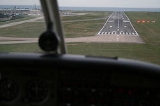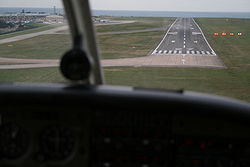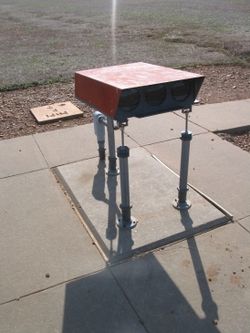
Precision Approach Path Indicator
Encyclopedia
Precision approach path Indicator (PAPI) is a visual aid that provides guidance information to help a pilot acquire and maintain the correct approach (in the vertical plane) to an aerodrome or an airport. It is generally located beside the runway approximately 300 metres beyond the landing threshold of the runway.  The greater number of red lights visible compared with the number of white lights visible in the picture means that the aircraft is flying below the glideslope. To use the guidance information provided by the aid to follow the correct glideslope a pilot would manoeuvre the aircraft to obtain an equal number of red and white lights.
The greater number of red lights visible compared with the number of white lights visible in the picture means that the aircraft is flying below the glideslope. To use the guidance information provided by the aid to follow the correct glideslope a pilot would manoeuvre the aircraft to obtain an equal number of red and white lights.
 The PAPI is a light array positioned beside the runway
The PAPI is a light array positioned beside the runway
. It normally consists of four equi-spaced light units colour coded to provide a visual indication of an aircraft's position relative to the designated glideslope for the runway. An abbreviated system consisting of two light units can be used for some categories of aircraft operations. The international standard for PAPI is published by the International Civil Aviation Organisation (ICAO) in " Aerodromes, Annex 14 to the Convention on International Civil Aviation, Volume 1 , Chapter 5". National regulations generally adopt the standards and recommended practices published by ICAO. An earlier glideslope indicator system, the Visual Approach Slope Indicator
(VASI) is now obsolete and was deleted from Annex 14 in 1995. The VASI only provided guidance down to heights of 200 ft whereas PAPI provides guidance down to flare initiation (typically 50 ft).
The PAPI is usually located on the left hand side of the runway at right angles to the runway centre line. The units are spaced 9 metres apart with the nearest unit 15 metres from the runway edge. PAPI can, if required, be located on the right hand side of the runway . At some locations PAPI are installed on both sides of the runway but this level of provision is beyond the requirements of ICAO. The light characteristics of all light units are identical. In good visibility conditions the guidance information can be used at ranges up to five miles by day and night. At night the light bars can be seen at ranges of at least twenty miles.
Each light unit consists of one or more light sources, red filters and lenses. Each light unit emits a high intensity beam. The lower segment of the beam is red and the upper part white. The transition between the two colours must take place over an angle not greater than three minutes of arc. This characteristic makes the colour change very conspicuous, a key feature of the PAPI signal. To form the PAPI guidance signal the colour transition boundaries of the four units are fixed at different angles. The lowest angle is used for the unit furthest from the runway, the highest for the unit nearest to the runway. The designated glideslope is midway between the second and third light unit settings. Depending on the position of the aircraft relative to the specified angle of approach, the lights will appear either red or white to the pilot
. The pilot will have reached the normal glidepath (usually 3 degrees) when there is an equal number of red and white lights. If an aircraft is beneath the glidepath, red lights will outnumber white; if an aircraft is above the glidepath, more white lights are visible.
PAPI systems are readily available from airfield lighting manufacturers worldwide. PAPI is normally operated by ATC. If ATC services are not normally provided at an aerodrome PAPI along with other airport lights, may be activated by the pilot
by keying the aircraft microphone with the aircraft's communication radio tuned to the CTAF or dedicated pilot activated lighting (PAL) frequency.
A typical engineering design specification for a PAPI light unit is shown below;
Optical construction:
As of 2008 PAPIs are starting to be made using solid state LED lamp
s instead of incandescent lamps. At the present time LEDs still do not produce sufficient brightness to satisfy ICAO light intensity and beamspread standards. Average lifetime with the LED based systems is 50,000 hours or more. By using LEDs the power consumption can be lowered considerably. The LED systems run internally on DC voltage so the DC voltage requirements along with the low power consumption now allow for Solar powered PAPIs.
The PAPI system is co-opted for use by the final approach
Runway Occupancy Signal (FAROS) system being introduced at several major airports in the United States for the purpose of allowing pilots to resolve a runway incursion
without requiring a priori notice of an occupied runway from the control tower
. In FAROS, automated line-of-sight runway sensors detect if a vehicle has committed a runway incursion and if so, will flash the PAPI lights to alert the pilot of an aircraft on final approach that the runway is currently occupied. The pilot then becomes responsible for resolving the conflict by notifying the air traffic controller
and executing a go-around
. Once the tower has ascertained that the runway has been cleared, the ground controller resets the PAPI so that landing operations may resume.


Runway
According to ICAO a runway is a "defined rectangular area on a land aerodrome prepared for the landing and take-off of aircraft." Runways may be a man-made surface or a natural surface .- Orientation and dimensions :Runways are named by a number between 01 and 36, which is generally one tenth...
. It normally consists of four equi-spaced light units colour coded to provide a visual indication of an aircraft's position relative to the designated glideslope for the runway. An abbreviated system consisting of two light units can be used for some categories of aircraft operations. The international standard for PAPI is published by the International Civil Aviation Organisation (ICAO) in " Aerodromes, Annex 14 to the Convention on International Civil Aviation, Volume 1 , Chapter 5". National regulations generally adopt the standards and recommended practices published by ICAO. An earlier glideslope indicator system, the Visual Approach Slope Indicator
Visual Approach Slope Indicator
The visual approach slope indicator is a system of lights on the side of an airport runway threshold that provides visual descent guidance information during the approach to a runway...
(VASI) is now obsolete and was deleted from Annex 14 in 1995. The VASI only provided guidance down to heights of 200 ft whereas PAPI provides guidance down to flare initiation (typically 50 ft).
The PAPI is usually located on the left hand side of the runway at right angles to the runway centre line. The units are spaced 9 metres apart with the nearest unit 15 metres from the runway edge. PAPI can, if required, be located on the right hand side of the runway . At some locations PAPI are installed on both sides of the runway but this level of provision is beyond the requirements of ICAO. The light characteristics of all light units are identical. In good visibility conditions the guidance information can be used at ranges up to five miles by day and night. At night the light bars can be seen at ranges of at least twenty miles.
Each light unit consists of one or more light sources, red filters and lenses. Each light unit emits a high intensity beam. The lower segment of the beam is red and the upper part white. The transition between the two colours must take place over an angle not greater than three minutes of arc. This characteristic makes the colour change very conspicuous, a key feature of the PAPI signal. To form the PAPI guidance signal the colour transition boundaries of the four units are fixed at different angles. The lowest angle is used for the unit furthest from the runway, the highest for the unit nearest to the runway. The designated glideslope is midway between the second and third light unit settings. Depending on the position of the aircraft relative to the specified angle of approach, the lights will appear either red or white to the pilot
Aviator
An aviator is a person who flies an aircraft. The first recorded use of the term was in 1887, as a variation of 'aviation', from the Latin avis , coined in 1863 by G. de la Landelle in Aviation Ou Navigation Aérienne...
. The pilot will have reached the normal glidepath (usually 3 degrees) when there is an equal number of red and white lights. If an aircraft is beneath the glidepath, red lights will outnumber white; if an aircraft is above the glidepath, more white lights are visible.
PAPI systems are readily available from airfield lighting manufacturers worldwide. PAPI is normally operated by ATC. If ATC services are not normally provided at an aerodrome PAPI along with other airport lights, may be activated by the pilot
Pilot Controlled Lighting
Pilot Controlled Lighting , also known as Aircraft Radio Control of Aerodrome Lighting or Pilot Activated Lighting , is a system which allows aircraft pilots to control the lighting of an airport or airfield's approach lights, runway edge lights, and taxiways via radio. At some airfields, the...
by keying the aircraft microphone with the aircraft's communication radio tuned to the CTAF or dedicated pilot activated lighting (PAL) frequency.
A typical engineering design specification for a PAPI light unit is shown below;
Optical construction:
- Preadjusted 2-lamp optical assembly.
- Anodized aluminium reflectors.
- Red colour filters.
- Precision-ground lenses.
- Lamps and reflectors replaceable without recalibration.
- 2 x 200 W / 6,6 A prefocused halogen lamps, Pk30d base.
- Average lifetime 1000 hours at rated current.
As of 2008 PAPIs are starting to be made using solid state LED lamp
LED lamp
An LED lamp is a solid-state lamp that uses light-emitting diodes as the source of light. The LEDs involved may be conventional semiconductor light-emitting diodes, organic LEDs , or polymer light-emitting diodes devices, although PLED technologies are not currently commercially available.Since...
s instead of incandescent lamps. At the present time LEDs still do not produce sufficient brightness to satisfy ICAO light intensity and beamspread standards. Average lifetime with the LED based systems is 50,000 hours or more. By using LEDs the power consumption can be lowered considerably. The LED systems run internally on DC voltage so the DC voltage requirements along with the low power consumption now allow for Solar powered PAPIs.
The PAPI system is co-opted for use by the final approach
Final approach (aviation)
A final approach is the last leg in an aircraft's approach to landing. In aviation radio terminology, it is often shortened to "final".In a standard airport landing pattern, which is usually used under visual meteorological conditions , aircraft turn from base leg to final within one to two miles...
Runway Occupancy Signal (FAROS) system being introduced at several major airports in the United States for the purpose of allowing pilots to resolve a runway incursion
Runway incursion
A runway incursion is an incident where an unauthorized aircraft, vehicle or person is on a runway. This adversely affects runway safety, as it creates the risk that an airplane taking off or landing will collide with the object...
without requiring a priori notice of an occupied runway from the control tower
Control tower
A control tower, or more specifically an Air Traffic Control Tower , is the name of the airport building from which the air traffic control unit controls the movement of aircraft on and around the airport. Control towers are also used to control the traffic for other forms of transportation such...
. In FAROS, automated line-of-sight runway sensors detect if a vehicle has committed a runway incursion and if so, will flash the PAPI lights to alert the pilot of an aircraft on final approach that the runway is currently occupied. The pilot then becomes responsible for resolving the conflict by notifying the air traffic controller
Air traffic controller
Air traffic controllers are the people who expedite and maintain a safe and orderly flow of air traffic in the global air traffic control system. The position of the air traffic controller is one that requires highly specialized skills...
and executing a go-around
Go-around
A go-around is an aborted landing of an aircraft that is on final approach.- Origin of the term :The term arises from the traditional use of traffic patterns at airfields. A landing aircraft will first join the circuit pattern and prepare for landing in an orderly fashion...
. Once the tower has ascertained that the runway has been cleared, the ground controller resets the PAPI so that landing operations may resume.
See also
- Approach lighting systemApproach Lighting SystemAn approach lighting system, or ALS, is a lighting system installed on the approach end of an airport runway and consisting of a series of lightbars, strobe lights, or a combination of the two that extends outward from the runway end...
(ALS) - Pilot controlled lightingPilot Controlled LightingPilot Controlled Lighting , also known as Aircraft Radio Control of Aerodrome Lighting or Pilot Activated Lighting , is a system which allows aircraft pilots to control the lighting of an airport or airfield's approach lights, runway edge lights, and taxiways via radio. At some airfields, the...
(PCL) - Visual approach slope indicatorVisual Approach Slope IndicatorThe visual approach slope indicator is a system of lights on the side of an airport runway threshold that provides visual descent guidance information during the approach to a runway...
(VASI) - Instrument landing systemInstrument Landing SystemAn instrument landing system is a ground-based instrument approach system that provides precision guidance to an aircraft approaching and landing on a runway, using a combination of radio signals and, in many cases, high-intensity lighting arrays to enable a safe landing during instrument...
(ILS) - Runway end identifier lights (REIL)
- Runway edge lightsRunway Edge LightsRunway Edge Lights are used to outline the edges of runways during periods of darkness or restricted visibility conditions. These light systems are classified according to the intensity they are capable of producing:...
(HIRL, MIRL, LIRL)

